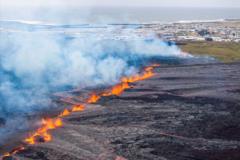As the eruption unfolded, many residents heeded warnings and evacuated promptly, but a small group opted to remain, despite the dangers, including hot water pipe breaks indicating soil instability. Local resident and town council president Asrun Kristinsdottir detailed the unnerving experience of preparing to flee while enduring relentless tremors. Another resident, Thormar Omarrson, who relocated his family last year after similar warnings, expressed a deep sense of loss over the impending threat to his hometown, emphasizing the emotional toll of such evacuations.
Most of Grindavik's 4,000 residents had evacuated previously due to ongoing volcanic threats, with the current eruption marking yet another episode in an active geological landscape that has seen repeated eruptions since 2021. Meteorologists indicated that this latest magma formation stretches about 11 km (6.8 miles) and signals a continuation of the region's unrest, which had not seen significant volcanic activity for centuries.
As authorities remain vigilant, the community’s strength is tested once more amid nature's powerful forces, with an eye on both safety and the costs of leaving their beloved home. Wind patterns are also being monitored as gas pollutants from the eruption could affect areas further northeast, including the capital.
The eruption serves as a poignant reminder of Iceland's dynamic geology, framed against its stunning natural beauty—an ongoing relationship between inhabitants and the earth beneath their feet that evolves with every seismic thrill.
Most of Grindavik's 4,000 residents had evacuated previously due to ongoing volcanic threats, with the current eruption marking yet another episode in an active geological landscape that has seen repeated eruptions since 2021. Meteorologists indicated that this latest magma formation stretches about 11 km (6.8 miles) and signals a continuation of the region's unrest, which had not seen significant volcanic activity for centuries.
As authorities remain vigilant, the community’s strength is tested once more amid nature's powerful forces, with an eye on both safety and the costs of leaving their beloved home. Wind patterns are also being monitored as gas pollutants from the eruption could affect areas further northeast, including the capital.
The eruption serves as a poignant reminder of Iceland's dynamic geology, framed against its stunning natural beauty—an ongoing relationship between inhabitants and the earth beneath their feet that evolves with every seismic thrill.






















